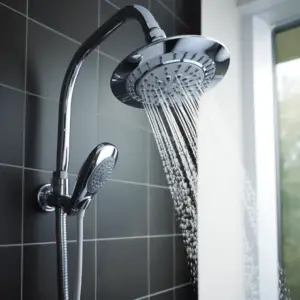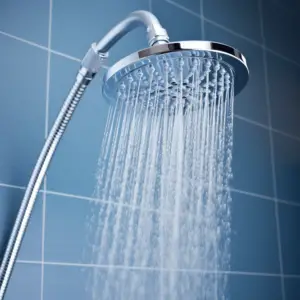Water Flow from Shower Head not getting any water coming out of your shower head, then it’s possible that you have a problem with either your shower head or the plumbing in your home.
Table of Contents
Reasons Why Water is Not Coming Out of Shower Head

Dirty Shower Head
The most common reason water isn’t coming out of your shower head is that it’s dirty.
Allowing soap scum, hard water deposits, and mineral buildup to accumulate on the inside of your shower head will restrict the flow of water through it.
To clean your shower head, all you need to do is remove it from its fixture and give it a thorough cleaning with a vinegar solution or baking soda and a toothbrush. Then rinse it well before reinstalling it back into place.
Low Water Pressure
If your water pressure isn’t strong enough, it won’t push water through your shower head. This can happen if there is a leak somewhere in your house or if you live in an area with low pressure.
To fix this problem, you may need to turn up the water pressure at your home’s main water line. If that doesn’t work, try replacing your shower head with one that has an adjustable spray pattern. This will allow you to change the pressure of your water flow by simply twisting or turning the head itself.
Check with your local utility company to see if they can help fix any leaks or increase your water pressure. If this doesn’t work, consider buying an inline flow restrictor to limit how much water flows through at once.
Water Restrictor
Water restrictor shower heads reduce shower water use. Hotels place water restrictors on faucets to comply with local water conservation rules.
If you look closely at your shower head, there may be a small screw or another device with a small knob. Turning this knob will remove the restrictor and allow more water to flow through the faucet.
Leakage
You may have a leak in your shower base or wall tile if water isn’t coming out of your shower head even though there’s pressure coming into it.
This can cause major damage if left untreated, so contact a plumber as soon as possible to repair any leaks in your home’s plumbing system.
If there is no leaky pipe in your home and all other parts of your plumbing system seem fine, then it could be that your shower arm or flange has become loose and is leaking water into the wall cavity behind it. Tightening up these pieces will solve most leaks around showers and baths.
Diverter Valve Malfunction
A diverter valve is a device that diverts the water from the tub spout to the shower head.
If it malfunctions, you won’t have any water coming out of your shower head. This could be caused by a clog in the diverter valve or a bad shower arm or flange.
You can check whether this is what’s causing your problem by checking if hot water still comes out of the tub spout when you turn on the hot water at the sink faucet. If not, then you need to replace your diverter valve.
Clogged Aerator
Water flow in a shower head is created by an aerator, which looks like a little screen. If this gets clogged with mineral deposits or other debris, it can restrict the flow of water out of the shower head.
You can remove the aerator from your shower arm and clean it with vinegar. Or you can replace it completely — just make sure to buy the right size replacement part so that it fits back on easily.
Corroded Pipes
Corrosion in pipes may cause low water pressure or no shower head water. Minerals in water cause corrosion, which can be remedied by repairing the faucet aerator or adding a water softener.
Clean shower head buildup with a gentle brush. If this doesn’t work, clean your shower head with vinegar or baking soda. Before reassembling, clean all crevices.
Loose Connection
If you find that water is coming out of your shower head, but it doesn’t feel like it’s spraying as hard as it used to, this could be due to a loose connection between the pipe and the shower head itself.
To fix this issue, simply tighten both ends of the pipe, so they are tightly secured together again.
Repairing Your Shower Head

The first step in deciding whether to repair or replace your shower head is diagnosing the issue.
Easy remedy for shower head base water dripping: A wrench can tighten loose connections.
If the water trickles out slowly when you turn on the tap, it’s usually clogged with mineral deposits and needs vinegar or baking soda to flush.
The fixture may need to be replaced if neither of these modifications work. It’s not always necessary—contact the manufacturer if your showerhead is under 10 years old and still under warranty. If your showerhead is older than 10 years, has no warranty, or you’re unsure, replace it.
If the water comes out slower than usual but doesn’t stop, your pipe may have been broken or leaked in the past. A plumber may be needed to solve this.
Conclusion
We hope these suggestions were a bit helpful. If someone in your house ever has this happen, any number of things may be going on. But hopefully, some of these simple steps should help you increase the flow of your shower head and address water conservation concerns.
